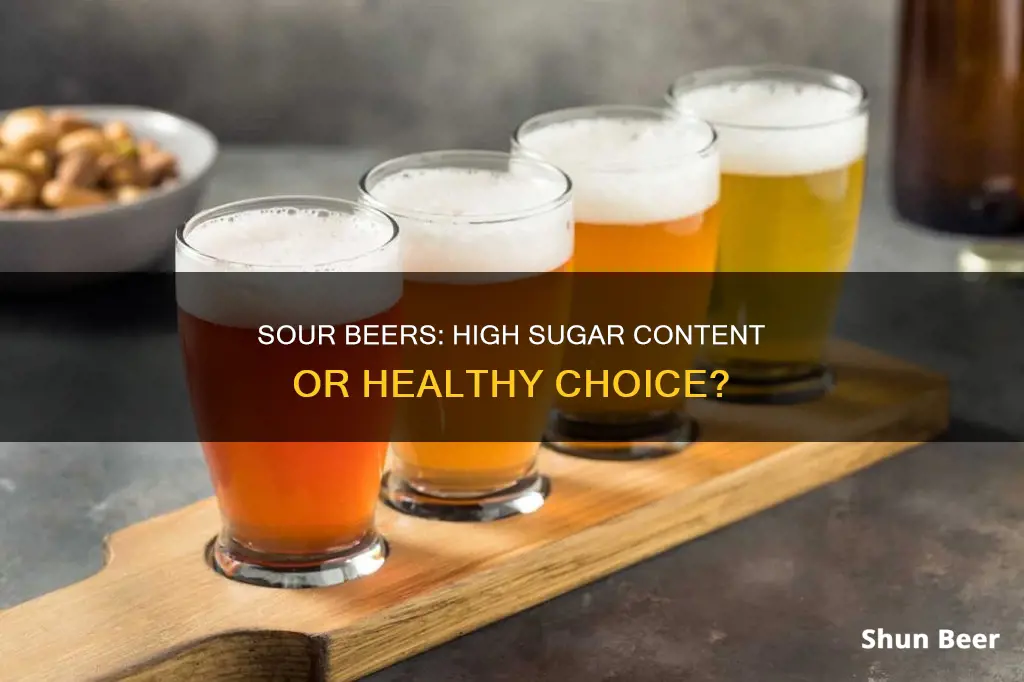
Sour beer is a unique brew that has gained popularity among seasoned beer drinkers and novices alike due to its distinctively sour taste. This taste is achieved through a brewing process that uses wild bacteria and yeast, such as lactobacillus and pediococcus, which convert sugar into lactic acid. While sugar is not added as an ingredient, it is essential in the beer-making process, and its conversion into alcohol results in a decrease in the final sugar content of the beer. As such, sour beers, like other beers, tend to have a low sugar content.
| Characteristics | Values |
|---|---|
| Sugar content | Sour beers are not high in sugar. Most beers contain little sugar, and the sugar that is present comes from the processing of the grains and is fermented by yeast to produce alcohol. |
| Calories | Beer is a significant source of calories. |
| Sour flavour | Sour beers get their distinctive sour flavour from the lactic acid produced by the Lactobacillus and Pediococcus bacteria during fermentation. |
| Alcohol content | Most sour beers are between 3-5% alcohol by volume (ABV). However, some may be as low as 2% or as high as 8-9% ABV. |
| Aging | Sour beers require a long aging period, typically between 3-18 months. |
| Brewing process | The brewing process for sour beer involves the use of wild bacteria and yeast, in contrast to other beers which use controlled strains of yeast. |
| Fermentation | Sour beers are fermented with multiple yeast strains and acid-producing bacteria, resulting in a more acidic taste than regular beers. |
| Yeast | Sour beers typically use wild yeasts like Brettanomyces, which provide sour notes and unique flavours that pure yeast cannot. |
| Bacteria | Lactobacillus and Pediococcus bacteria are commonly added during the brewing process, giving sour beer its signature tart, crisp flavours. |
| Fruit addition | Brewers often add fruit to sour beer, which contributes organic acids and creates a more tart taste. |
What You'll Learn

Sour beers are made using wild bacteria and yeast
Brettanomyces, or "brett", is a genus of yeast that is the principal wild yeast used in sour beer production. It produces specific flavours, aromas, esters, and phenols that range from pineapple and hay to horse blanket and acrid smoke. While brett doesn't contribute much to the acidity of sour beers, it can produce acetic acid when exposed to large amounts of oxygen, creating a vinegar-like sourness.
Lactobacillus, or "lacto", is a bacteria that acts similarly to yeast by consuming sugars in the wort. However, instead of converting these sugars to alcohol, lacto converts them to lactic acid, which lowers the liquid's pH and gives beer a sour yet clean taste. Pediococcus, or "pedio", is another lactic acid-producing bacteria used in sour beers. Pedio takes longer to age than lacto, allowing time for the primary yeast strain to complete its fermentation before the drop in pH occurs. Pedio can produce a buttery-popcorn flavour compound called diacetyl, so it is often used in combination with brett, which can "clean up" this undesirable flavour.
Acetobacter is a less common bacteria in sour beer production because it consumes ethanol and produces harsh-tasting acetic acid. However, it can be added in small amounts to achieve a low level of acetic acid, which is an important flavour component in traditional Flemish reds and Belgian lambics.
Best Low-Sugar Beers: The Sweetness Spectrum
You may want to see also

Sour beers are not high in sugar but are a source of carbohydrates
The sugar content in beer comes from two sources: fermentable sugars and oligosaccharides. Fermentable sugars, such as maltose, make up about 80% of the wort's sugar content. The remaining 20% is composed of oligosaccharides, which the yeast does not ferment. Oligosaccharides are also not digestible by the human body, so they are considered calorie-free.
While sour beers may not have a high sugar content, they do contain carbohydrates, which can affect blood sugar levels. Additionally, the alcohol content of beer is a significant source of calories. Regular beers tend to be sugar-free, while light beers typically have less than 1 gram of sugar per can. On the other hand, non-alcoholic beers have the highest sugar content among the different types of beer.
The unique flavour of sour beers comes from the use of wild bacteria and yeast during the brewing process. This is in contrast to other types of beer, which use controlled strains of yeast to produce more familiar flavours. Sour beers are also aged for a long period, which contributes to their distinct taste.
Sour beers are popular among beer drinkers and non-beer drinkers alike due to their tart flavour and aroma. They are considered to be complex and funky, with a wide range of flavours, from intensely sour to light and fruity. Their low alcohol content, typically between 3%-5%, also makes them an easy-to-drink option.
Beer's Sugar Impact: What Happens in the Body?
You may want to see also

Sour beers are low in alcohol content
Sour beers are not high in sugar. In fact, all beer is relatively low in sugar, with most of the calories coming from alcohol. The sugar content in sour beers is comparable to that of other beers, and the sweetness comes from a balance of acidity.
The alcohol content in sour beers is influenced by the type of beer and the brewing conditions used. For example, Gose and Berliner Weisse are lower-alcohol wheat beers, typically with an ABV of around 3%. On the other hand, American wild ales may have a slightly higher ABV, but they still fall within the range of 3% to 5%.
The fermentation process also affects the alcohol content in sour beers. The use of wild yeast and bacteria during fermentation can lead to uncertainty in the brewing process, causing the beer to take longer to ferment and mature. However, modern methods have been developed to create sour beer within a typical timeframe for ales, usually several days.
The aging process can further impact the alcohol content in sour beers. As sour beers age, they may become more complex and mellow in flavour, and the malt characteristics may fade, resulting in a more pronounced sour taste. This ageing process can enhance the low alcohol content of sour beers, making them even more suitable for extended drinking sessions.
Beer's Sweet Secret: Sugar Content Explored
You may want to see also

Sour beers are difficult to make
While the process of making sour beers is not vastly different from brewing any other beer, it does come with its own set of challenges.
Firstly, traditional sour beers can take a long time to brew. Depending on the style and method, sour beers can take anywhere from six months to a few years to be ready to drink. This is because the microbes used to ferment the beer, such as lactobacillus and pediococcus, need time to do their work and develop the desired level of sourness.
Secondly, sour beers are finicky and unpredictable. Brewers often deal with blends of yeasts and bacteria, which can sometimes take the beer in unexpected directions. It can be challenging to dial in the exact amount of sourness, funkiness, and tartness desired. Additionally, the use of unusual ingredients, such as spices and flavourings, can be difficult to predict in terms of their impact on the final flavour.
Another challenge is the risk of contamination. The bacteria and wild yeast used in sour beers can contaminate brewing equipment and spoil other styles of beer. This is because the microbes can get into tiny cuts and gouges in plastic equipment, and it can be difficult to sanitise equipment thoroughly. As a result, many brewers choose to dedicate specific equipment solely for sour beer production.
Furthermore, the process of souring the beer requires careful control of the brewing environment. For example, oxygen exposure should be minimised during aging as several of the bugs that give sour beers their characteristic funkiness and tartness utilise oxygen to produce acetic acid, which can result in an undesirable vinegar-like flavour.
Lastly, the process of creating a sour beer requires a good understanding of the various flavour profiles that can be achieved. Sour ales encompass a wide array of styles, each with its own unique flavour profile. Brewers need to familiarise themselves with these different profiles to create the desired sour beer.
In summary, while brewing a sour beer follows the same basic steps as any other beer, the challenges lie in the nuances and intricacies of the process. It requires patience, experimentation, and a thorough understanding of the unique characteristics of sour beers.
Beer and Blood Sugar: What's the Connection?
You may want to see also

Sour beers are a crowd-pleaser
Sour beers are characterised by their sour, tart, or acidic taste, often with fruity notes. This distinct flavour profile is achieved through a brewing process that uses wild bacteria and yeast, such as lactobacillus and pediococcus, which convert sugar into lactic acid. The use of these "wild" organisms results in a wide range of flavours, from intensely sour to light and fruity.
The process of making sour beer is quite different from that of other beers. While most beers are brewed in a controlled setting with specific yeast strains, sour beers embrace wild yeast strains and bacteria. The fermentation process can take several months or even up to 18 months, depending on the desired level of sourness and lactic acid concentration. Additionally, sour beers are usually aged in wooden vessels, allowing for a diverse community of organisms to develop in the beer.
The result is a complex and flavourful beer that appeals to a wide range of palates. Beer lovers appreciate the complexity and uniqueness of sour beers, while those who don't typically enjoy the taste of beer find the fruity and tart flavours of sours more approachable. The lower alcohol content of sour beers, typically between 3%-5% ABV, also makes them a refreshing and sessionable option.
The versatility of sour beers extends to food pairings as well. The tart flavour of sour beers pairs exceptionally well with spicy foods, fatty cuts of beef, cured meats, deep-fried foods, strong cheeses, and mollusks.
Sour beers have a long history, dating back to the early 18th century in Belgium. They are considered the forefathers of many modern beers, as all beers were essentially sour beers before the advent of refrigeration and pasteurization technologies in the mid-19th century. Since the 1970s, sour beers have experienced a resurgence in popularity, with craft breweries around the world experimenting with new varieties and innovative flavours.
Beer and Blood Sugar: A Dangerous Mix?
You may want to see also
Frequently asked questions
Sour beers are not high in sugar. While sugar is necessary to produce alcohol, it is not added as an ingredient to beer. Instead, it comes from the processing of the grains and is then fermented by yeast to produce alcohol.
A sour beer is any beer with a sour, tart, or acidic taste. It may include fruits like cherry, raspberry, and peach to create a balance of sour and sweet flavors.
The process of making sour beer involves the fermentation of multiple yeast strains and acid-producing bacteria. This creates a more acidic taste than regular beers.







